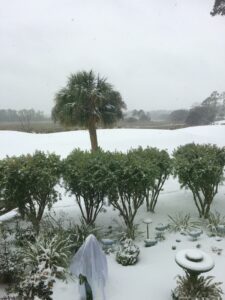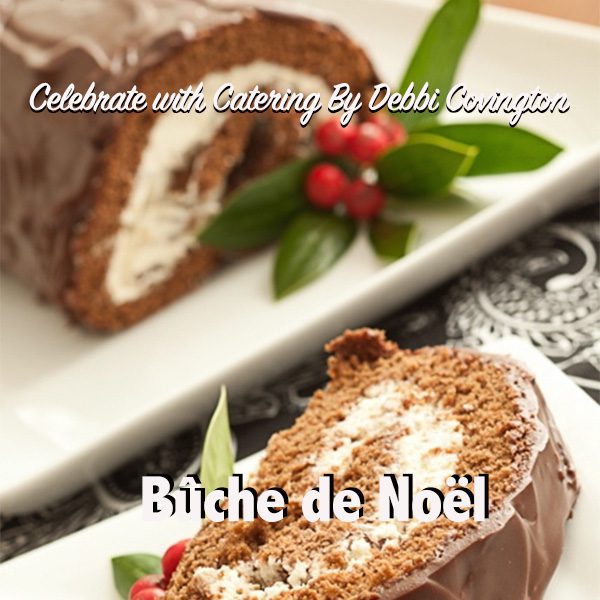 Polar Vortex—that is an awfully sophisticated name for what I have always called a “cold snap.”I have also heard areas of low pressure bringing cold called the “Montreal Express,” “Alberta Clipper,” or “Saskatchewan Screamer.” In Texas, they call them “Blue Northers.” In Colorado, cold fronts with snowstorms are referred to as “Colorado Hookers.” In our area, we get “Appalachian Runners.” Call it what you will, it means cold temperatures. In early January,2018, I woke up one morning to see snow on the palm trees. It was only a couple of inches, butthe entire area was paralyzed. Schools were closed and we were warned that the 28 degree temperature was life-threatening. I do remember wishing that I had brought some ice melt with me from northeastern Ohio. My ten–foot tall beautiful Philodendron was a pile of mush on the ground and my shell ginger looked most distressed.
Polar Vortex—that is an awfully sophisticated name for what I have always called a “cold snap.”I have also heard areas of low pressure bringing cold called the “Montreal Express,” “Alberta Clipper,” or “Saskatchewan Screamer.” In Texas, they call them “Blue Northers.” In Colorado, cold fronts with snowstorms are referred to as “Colorado Hookers.” In our area, we get “Appalachian Runners.” Call it what you will, it means cold temperatures. In early January,2018, I woke up one morning to see snow on the palm trees. It was only a couple of inches, butthe entire area was paralyzed. Schools were closed and we were warned that the 28 degree temperature was life-threatening. I do remember wishing that I had brought some ice melt with me from northeastern Ohio. My ten–foot tall beautiful Philodendron was a pile of mush on the ground and my shell ginger looked most distressed.
Was there permanent damage to our gardens? Some citrus trees did not survive and Washingtonian palms which are native to Baja, Mexico lost their fan-like fronds. Some ferns were unhappy looking. Despite the snow and cold in five months, my Philodendron was back to its large and lush self. My geraniums and snapdragons acted as if nothing had happened.
The lesson learned? Our plants are pretty darn hardy. Now Tropical plants are another matter. If you have house plants outside on a deck or porch, a freeze can damage them or even cause their demise. They should be brought indoors if possible or moved close to the house. You can also cover them. Do not use plastic or a tarp. Plants like people must breathe and plastic will smother them. An old sheet can provide protection from the cold or you can purchase frost fleece or a frost “blanket” at many garden centers. Outdoor citrus can also be covered. Some people wind outdoor Christmas lights around their trees to provide extra warmth. Hydrating your garden before the hard freeze is also helpful. Desiccation can cause leaf damage and drop. You can turn on your irrigation the day before a freeze alert. Our ground does not freeze to an extent where we must drain irrigation systems as you do farther north. I run my irrigation for a bit in the winter if we have had a dry spell.
What plants will show some damage after a frost? Shell ginger (Alpinia zerumbet) might die back, but it almost always rebounds during warmer weather. A popular small shrub known as duranta gold mound will have black leaves instead of its usual bright yellow. Cut the damaged leaves off when danger of a frost is past. As mentioned before, Philodendrons might collapse in a mushy mess. Once it is warm again, I clear away the decayed plant matter to prevent fungal disease and the plant will come back.
One thing that most golfers will know is that you must not walk upon frost coated grass. This can break the grass fibers and cause damage. That is the reason for the dreaded “frost delay” this time of the year. Although our sun is low in the sky, it still provides warmth and frost usually burns off in a short time. These are good mornings to enjoy that extra cup of coffee before heading out.
The most important thing to remember about our cold spells is to be patient. Do not give up on a plant because it is looking stressed. Leave it be and when spring arrives, chances are that you can remove any damaged plant material and it will revive. If the plant has not put out new growth by May 1, then it probably was the wrong plant in the wrong place and probably belongs in southern Florida or Mexico.








